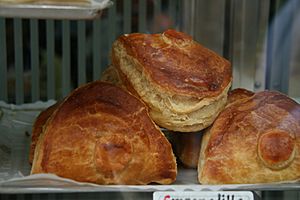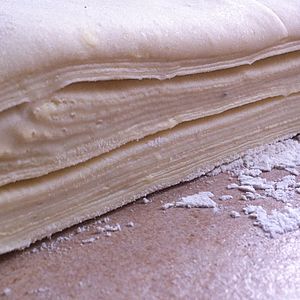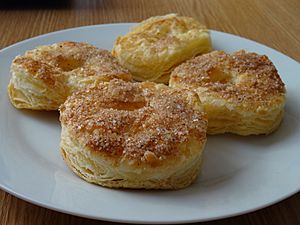Puff pastry facts for kids
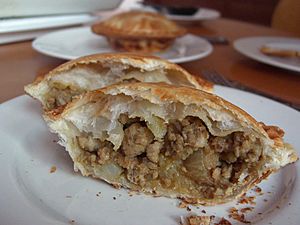
A chicken pot pie made with puff pastry
|
|
| Alternative names | Water dough, détrempe, pâte feuilletée |
|---|---|
| Type | Pastry |
| Region or state | Spain |
| Main ingredients | Butter, flour, water |
Puff pastry, also known as pâte feuilletée, is a flaky light pastry made from a laminated dough composed of dough (détrempe) and butter or other solid fat (beurrage). The butter is put inside the dough (or vice versa), making a paton that is repeatedly folded and rolled out before baking.
The gaps that form between the layers left by the fat melting are pushed (leavened) by the water turning into steam during the baking process.
History
Puff pastry seems to be related to the Greek phyllo, and is used in a similar manner to create layered pastries. Puff pastry appears to have evolved from thin sheets of dough spread with olive oil to laminated dough with layers of butter.
The origin of modern puff pastry appears to be Spanish, perhaps through Arab or Moorish influences: the first known recipe of modern puff pastry (using butter or lard) appears in the Spanish recipe book Libro del arte de cozina (Book on the art of cooking) written by Domingo Hernández de Maceras and published in 1607. Maceras, the head cook in one of the colleges of the University of Salamanca, already distinguished between filled puff pastry recipes and puff pastry tarts, and even mentions leavened preparations. Francisco Martínez Motiño, head chef to Philip II of Spain (1527-1598), also gave several recipes of puff pastry in his Arte de cocina, pastelería, bizcochería y conservería published in 1611. In this book, puff pastry is abundantly used, particularly to make savoury game pies, and some Spanish commentators such as Dionisio Pérez Gutiérrez have gone so far as to credit Martínez Montiño with having invented puff pastry. In his novel El Buscón (published in 1627 but written in 1604), the Spanish writer Francisco de Quevedo caustically suggests that the puff pastry pies sold at the inn of some Simón de Paredes in Madrid were being adulterated with human flesh. Thus, puff pastry appears to have had widespread use in Spain by the beginning of the 17th century. While traditionally ascribed to the French painter and cook Claude Lorrain (1600-1682) (the story goes that Lorrain was making a type of very buttery bread for his sick father, and the process of rolling the butter into the bread dough created a croissant-like finished product), the story is spurious. In fact, the first French recipe of puff pastry was published in François Pierre La Varenne's "Pastissier françois" in 1653, postdating the earlier Spanish recipes by almost 50 years.
Production
The production of puff pastry dough can be time-consuming, because it must be kept at a temperature of approximately 16 °C (60 °F) to keep shortening from becoming runny, and must rest in between folds to allow gluten strands time to link up and thus retain layering.
The number of layers in puff pastry is calculated with the formula:
where  is the number of finished layers,
is the number of finished layers,  the number of folds in a single folding move, and
the number of folds in a single folding move, and  is how many times the folding move is repeated. For example, twice-folding (i.e. in three), repeated four times gives
is how many times the folding move is repeated. For example, twice-folding (i.e. in three), repeated four times gives  layers. Chef Julia Child recommends 73 layers for regular pâte feuilletée and 729 (i.e. 36) layers for pâte feuilletée fine (in Volume II of her Mastering the Art of French Cooking textbook).
layers. Chef Julia Child recommends 73 layers for regular pâte feuilletée and 729 (i.e. 36) layers for pâte feuilletée fine (in Volume II of her Mastering the Art of French Cooking textbook).
Commercially made puff pastry is available in grocery stores. Common types of fat used include butter, vegetable shortenings, lard and margarine. Butter is the most common type used because it provides a richer taste and superior mouthfeel. Shortenings and lard have a higher melting point therefore puff pastry made with either will rise more than pastry made with butter, if made correctly. Puff pastry made in this manner will, however, often have a waxy mouthfeel and more bland flavor. Specialized margarine formulated for high plasticity (the ability to spread very thin without breaking apart) is used for industrial production of puff pastry.
Variants and distinctions
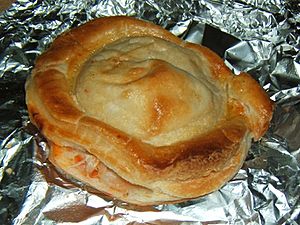
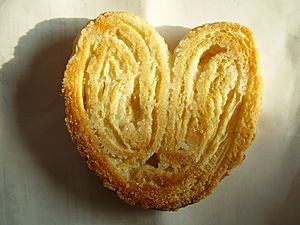
- Further information: Flaky pastry
Since the process of making puff pastry is generally laborious and time-intensive, faster recipes are fairly common: known as "blitz", "rough puff", or "flaky pastry". Many of these recipes combine the butter into the détrempe rather than adding it in the folding process and are thus similar to a folded short crust.
Puff pastry can also be leavened with baker's yeast to create croissants, Danish pastry, Spanish milhoja, or Portuguese empanadilla; though such preparations are not universally considered puff pastries.
Puff pastry differs from phyllo (filo) pastry, though puff pastry can be substituted for phyllo in some applications. Phyllo dough is made with flour, water, and fat and is stretched to size rather than rolled. When preparing phyllo dough, a small amount of oil or melted fat (usually butter) is brushed on one layer of dough and is topped with another layer, a process repeated as often as desired. When the phyllo bakes it becomes crispy, but since it contains somewhat less water, does not expand to the same degree as puff pastry. Puff pastry also differs from Austrian strudel dough, or Strudelteig, which more closely resembles phyllo.
Uses
- Beef Wellington
- Cheese straws
- Croline
- Croissants
- Galette des rois
- Jambons
- Miguelitos
- Mille-feuille
- Palmier
- Pastel de nata
- Pithivier
- Sausage rolls
- Steak and kidney pie and other types of pie
- Strudel
- Tarte conversation
- Tarte Tatin
- Torpedo dessert
- Turnovers
See also
 In Spanish: Hojaldre para niños
In Spanish: Hojaldre para niños


